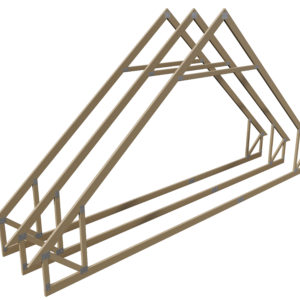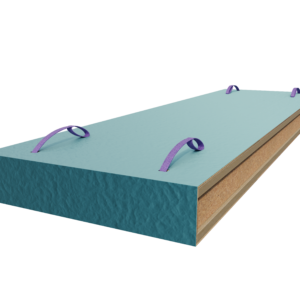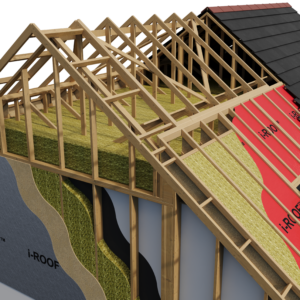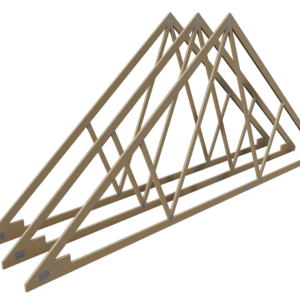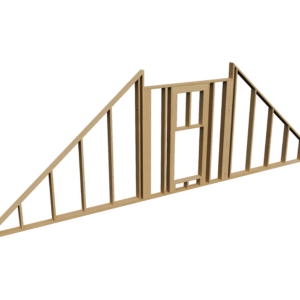-
Attic Trusses
Read moreAttic, or “room in the roof”, trusses are becoming increasingly popular. They offer increased living space without changing the footprint of the house, delivering maximum value to the builder and homeowner.
Benefits of Attic Trusses
- Structural roof and floor in single component
- Elimination of complex labour intensive site work
- Posi-Attic trusses provide easy installation of services including mechanical ventilation & heat recovery systems
- Reduced build cost per square metre due to full utilisation of space
- Increased living space achieved without changing footprint of house
- Lower member of truss provides floor platform
- Full utilisation of loft space provides benefits for both builder and homeowner
- Complete roof structure provided ready for floor boarding, roof finishes and plasterboard
- Engineered to take the loads associated with an additional room
- Factory assembled components ensure consistent quality
-
Flat Roof Cassettes
Read moreOur roof cassettes are precision-engineered offsite components, used in place of traditional on-site construction methods to quickly deliver flat roofs. With a design based on our in-depth industry knowledge and extensive experience, these innovative timber systems have been developed to meet the evolving demands of the construction sector, with rapid installation and a high percentage of pre-manufactured value.
Benefits of Roof Cassettes
- High quality yet rapid external finish on projects
- Improved health and safety on site
- Reduced construction time on site
- Bespoke design with incorporated M&E considerations
- Less waste material on site
- Cassettes use either PEFC or FSC®, certified timber
- Fantastic thermal qualities
- Large spans can be achieved due to the cassette’s engineered joist construction
- Impressive dimensional accuracy & reliable build quality
- Dramatically reduced build times
- Complete design, fabrication & delivery service
-
Glulam Beams
Read moreGlulam is the commonly used abbreviation for Glued Laminated Timber. Glulam’s tensile characteristics make it suitable for long span, load-bearing widths, such as bridges. It is an exceptionally strong material, used for load-bearing structures where visual appearance is important. It can also be shaped, helping to form spacious buildings.
Benefits of Glulam Beams
- Suitable for large spans
- High strength to weight ratio
- Straight, shaped and curved forms
- Natural beauty & appearance of timber
- Excellent fire resistant properties
- Resistant to aggressive chemical environments
- Easy to handle, can be worked using ordinary tools
- Surface can be treated
- Sourced from well managed forests (Chain of Custody certified)
- Minimal environmental impact when manufactured
- Recyclable
- Eco-friendly and biodegradable, generating less atmospheric CO2 relative to other building products
- Thermally efficient
-
i-RoofTM
Read moreThe i-Roof offers a comprehensive solution for constructing room-in-roof designs for 2.5 storey homes, encompassing walls, floors, and roofs with insulation and plasterboard.
Benefits of i-Roof
- Speeds Up Build Time
- Extra Living Space
- High Quality Guaranteed
- Improve Health and Safety
-
Roof Trusses
Read moreOff-site manufactured roof trusses are the most widely used form of roof framing in the UK as they provide a cost-effective and flexible solution.
Trusses are not only now “the norm” for simple roof structures but also increasingly seen as the ideal method of framing to turn a complex architectural vision into a working roof structure.
-
Spandrel Panels
Read moreA spandrel panel, is a factory produced prefabricated panel used as a dividing wall or in place of a traditional gable block wall, which is manufactured off-site to save construction time on-site.
Spandrel panels can also help improve safety onsite, as they require less time working at height.
Benefits of Spandrel Panels
- One trade time‐saving roof solution
- Avoids additional scaffolding cost
- System allows continuity of work when installing roof framing
- Easy to install, no complex anchorage methods
- Factory fitted slings for handling during off load and erection
- Available to satisfy all roof layouts from the simple to the most complex
